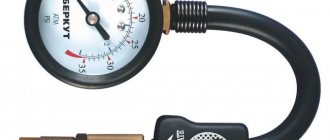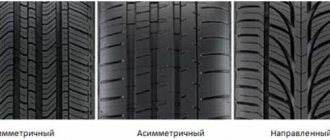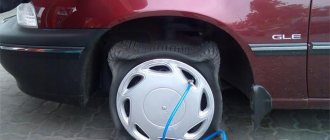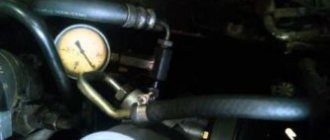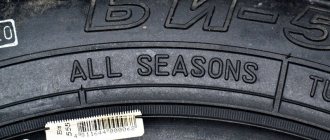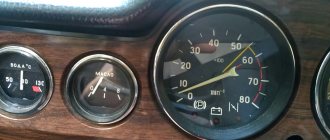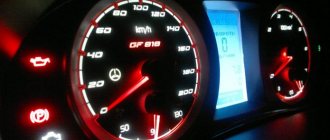28.04.2021
| (Votes: 1, Rating: 5) |
Issues discussed in the material:
- Tire pressure indicator
- Problems with incorrect tire pressure
- The process of checking car tire pressure
- 5 Tips for Maintaining Tire Pressure
- Installing pressure sensors on cars
- Reviews from car owners about tire pressure sensors
Every vehicle owner must know how to check tire pressure. Rapid wear of tires, increased fuel consumption, increased likelihood of a puncture - this is not a complete list of troubles that a motorist faces if he neglects this issue.
Fortunately, determining tire pressure is not difficult at all. It won't take much time to work - it will take just a few minutes on all four wheels. But in the end, such a procedure will save you from many problems. You just need to not be lazy and do it on a regular basis.
Tire pressure indicator
Tire pressure is a parameter indicating the volume of air per 1 cm2 of tire area. Units of measurement are kilopascals or kg/cm2 of tire area.
The permissible tire pressure will vary depending on the make of the car, the characteristics of the wheels, and the road. In most cases, car manufacturers indicate the optimal and maximum tire pressure on special plates located on the doors of the vehicle or in the glove compartment area.
Additionally, this information can be found in your car's owner's manual, so be sure to read it to know what your tire pressure should be.
Many motorists cannot figure out what tire pressure value is acceptable, since this indicator is different on the tires and in the car’s operating manual.
To avoid confusion, remember that on the outside of the tires it is not the optimal pressure that is indicated, but the maximum. This means that before purchasing tires, you should carefully read the car’s operating instructions to find out the optimal tire pressure. Then you can choose tires of the desired width and suitable profile.
Note!
Tire pressure constantly changes depending on the ambient temperature. In the hot season, this figure becomes higher, so it is necessary to bleed the air from the nipple so as not to drive a car with overinflated wheels. On the contrary, it is important to regularly inflate your tires during the winter months.
Schrader valve
1 - sealing sleeve; 2 - seal; 3 - threaded bushing; 4 — spool rod; 5 — valve body; 6 - valve body; 7 - conical spring; 8 — valve cup. The spools of the old (a) and new (b) samples are completely interchangeable. The air resistance is approximately the same.
If you have looked into the hole in the wheel valve, you have probably seen a spool there. This device, standardized throughout the world, is used not only in the wheels of cars, motorcycles and bicycles, but also in air conditioners, scuba gear and other elements of pneumatic equipment.
It is the Schrader valve that creates the main resistance to the air flow. Because of its influence, no pressure gauge will show the correct pressure while the compressor is inflating the tire.
- When planning to go off-road, it is always better to put chains on your wheels in advance. If the need for chains is not obvious, make sure that bracelets are available. Antibuks will also come in handy!
Source
Problems with incorrect tire pressure
Every motorist should know how to check tire pressure to ensure safe driving. This parameter affects how the vehicle is controlled, behaves on a bad road, and how accurately it maintains its trajectory when driving through potholes. If the pressure is too high, the tire may burst, and this can lead to an accident: the car will roll over.
If the pressure is too high or, conversely, low, the car’s fuel consumption increases by 10–15%. As a result, you will have to spend more money on gas. To prevent this from happening, you must know how to properly check tire pressure and do it regularly. You may need to inflate your tires every 2-3 months.
If this parameter is more or less than required, the tread will begin to wear unevenly. For example, the tire will wear out in the middle or along the edges. As a result, you will have to throw away a recently purchased set of tires that you have only ridden on for a couple of years and buy new wheels. But their cost is quite high.
If you don't have a tire pressure gauge and don't measure it regularly, your suspension will experience increased stress if your tires are over- or under-inflated. This will cause the ball joints and steering ends to fail ahead of time, as well as the shock absorbers. Therefore, you will have to not only buy a new set of wheels, but also carry out expensive repairs to the car’s chassis, and this is also an additional expense.
Requirements for pressure gauges
First, let's look at the requirements for pressure gauges according to GOST:
- Installation of the device in accordance with GOST can be carried out on the vessel fitting up to the shut-off valves.
- The main requirement according to GOST, which must be presented, concerns such a nuance as the error of the pressure gauge. The accuracy class must be at least 2.5 if the operating pressure level is below 25 kg/cm2. If the pressure is higher, then the accuracy class should be equal to 1.5.
- Any device according to GOST is equipped with a scale so that the measurement limit of the required parameter is located in the second third of the scale.
These are the basic requirements that apply to devices of this type in accordance with GOST.
Pressure sensor on Daewoo compressor
The process of checking car tire pressure
Many motorists do not use a pressure gauge to check tire pressure. They do this in traditional ways: by visually inspecting the tires, and by kicking the wheel. However, such methods do not provide accurate results. You can only tell if the pressure is too low if the tires are completely flat. But in this case, you can’t travel by car at all. Therefore, experienced car owners, in order to understand whether everything is in order with the wheels, always use a pressure gauge - a special device with which you can check the pressure in the tires.
How this procedure is performed:
- You must park the car on level asphalt.
- Then you need to remove the nipple protective cap, connect the pressure gauge and measure the pressure. It is important that the connection is sealed so that air does not escape from the tires and you will get a 100% accurate result.
- It is important to take several measurements to verify the data obtained. Remember that the units for measuring tire pressure can be different: bar, kPa, kg/cm2 and psi, they have differences. To avoid making a mistake, check that the tire pressure is 2.2 kg/cm2, and not 2.2 psi, for example.
- Did you find out that the tires were flat? Then you need to pump them up using a special pump or compressor. If the obtained value exceeds the norm, the pressure should be relieved. To do this, press the nipple valve.
- Upon completion of these manipulations, check the tire pressure again. If the value is optimal, put the cap back on and start measuring on other tires.
We recommend
“How to reset a tire pressure error: a few simple ways” Read more
Depending on the manufacturer, tire pressure can be measured in different units. Here's how the most common pressure units relate to each other:
- 1 bar = 0.98692 atm = 1.0197 atm (kgf/cm²) = 105 Pa = 14.504 psi;
- 1 atm = 1 kgf/cm² = 0.96784 atm = 0.980665 bar = 14.223 psi;
- 1 atm = 1.01325 bar = 1.033 atm = 14.696 psi.
If you are confused and cannot measure your pressure correctly, special tables containing the necessary data will help you. You can find such tables on the Internet. With their help, you can find out the value of any quantity. For clarity, here is an option with the most common units of measurement:
How often do experienced motorists check their tire pressure? Many are sure that this needs to be done every 14 days. However, in reality, it is necessary to determine the value of this parameter more often. This requirement is explained by the fact that tire pressure is influenced by many factors. For example, how carefully the driver drives the car, what the characteristics of the tire are, and whether there are temperature changes.
So, in the hot season, you should check whether your tires are properly inflated every 200,000–300,000 kilometers.
Also remember that if the temperature increases or decreases by 10 degrees Celsius, the tire pressure will change by 1 psi. In addition, it is necessary to check the tire pressure if the car has not been driven for a long time.
How to check tire pressure correctly? Measurements should be taken in the morning, when the wheels have not yet warmed up. This way the results obtained will be more accurate. If you have just parked your car after a long drive, you will have to wait 3-4 hours for the temperature of the tires to drop. Only after this can you begin to measure on all four wheels using a special device.
note
! There are cases when a slight deviation of the pressure value from that recommended by the car manufacturer is acceptable. For example, you have to travel on a bad road or if the car is overloaded. In such situations, it is allowed to violate the requirements and relieve the pressure or, conversely, pump up the tires.
However, after driving in difficult conditions is completed, it is necessary to adjust the tire pressure to the optimal value so that this parameter meets the manufacturer's requirements.
Accuracy of pressure gauge readings: don’t trust - check
A pressure gauge is a device whose purpose is to measure pressure levels. And the need to measure a motorist’s pressure may arise in different cases. You can find out more about how car pressure gauges are checked at home and what requirements apply to these devices below.
Installing pressure sensors on cars
Statistics confirm that most motorists do not check whether their tires are properly inflated before driving. As a result, the risk of road accidents increases. At the same time, about 40% of drivers measure their blood pressure once every 12 months.
If you do not want to regularly measure with a pressure gauge, you can install pressure sensors. This is a new option that will help reduce the risk of an emergency. The use of sensors will increase the service life of tires.
Today, you can purchase different models of sensors in specialized stores. There are external devices; they are installed in place of the spools. Their work is based on the air blocking mechanism in the wheel.
Some sensors that can be bought at a car store show changes in tire pressure as a result of natural fluctuations. However, such devices have a disadvantage: they are not protected from mechanical damage, they can be stolen, and no special devices are required.
We recommend
“Air pressure in wheels: what should it be and how to measure it” Read more
Sensors installed inside are more reliable, since vandals will not be able to reach them. Such devices are located inside the tire. If they want to steal them, they will have to twist the wheel completely. However, the cost of such sensors is quite high.
Differences between sensors may also be in the way pressure is determined. Based on this, there are several types of devices.
The most budget option is mechanical sensors installed externally. They have a simple design. The operating principle is as follows: the cap is shifted under air pressure in the wheels from the green area of normal pressure to the red area of low pressure. Such devices do not have chips and are not capable of transmitting data to the control panel. Therefore, you can find out the resulting value only visually.
Electronic sensors are more complex, but they are more convenient to use. They contain a chip that transmits data to the display. There are 2 positions: green - the pressure is normal, red - the indicator is higher or lower than optimal.
Internal electronic sensors are the most complex, but the cost of such devices is higher. They consist of an internal part, which is installed in the tires, and an external part - a small computer. With its help, data is collected from sensors and the information received is analyzed. Then the display shows the tire temperature, rotation speed and other parameters. The most modern sensor models are capable of transmitting information to the car owner’s phone using special software.
You can install simple sensors with your own hands, the main thing is to study the chosen model and how it works. On some vehicles, such devices are installed at the factory. However, not all cars are equipped with them.
Reviews from car owners about tire pressure sensors
- It is better to install internal ones. “Have you decided to install sensors? Then choose internal models. They can be mounted wherever you want. The cost of such devices is high, but they function without interruption. The battery of such a sensor is enough for 2-3 years of use.”
- I don't trust electronics.
“I don’t see the point in installing sensors. Of course, if you don't mind the money, then buy it. And then, how will you understand that they are out of order? It’s easier for me to check the pressure myself; I spend a couple of minutes on this. But I’m sure that everything is fine with the wheels.” - Protection against sclerosis.
“I installed sensors, now I don’t need to constantly measure pressure. Previously, before each trip I was constantly worried about whether the tires were properly inflated, and I spent time checking. Once I was in a hurry to get to work and forgot to measure the pressure, then it turned out that the tires were flat. It’s good that the accident didn’t happen.” - I haven't decided yet.
“I haven’t decided yet whether to install sensors. But if I’m going to buy them, I’ll choose the outdoor model. It seems to me that there is a lot of fuss with the internal ones. If the battery runs out or the device breaks, you will have to disassemble the wheel. Either do this work yourself, which is a waste of time and effort, or go to a service station, which is an extra expense.” - It all depends on the situation.
“I’m sure that sensors are needed. Now, if you puncture a tire and the wheel is tubeless, you will never know that the pressure is low. The device will immediately show that there are problems. But if you do not travel long distances and drive carefully, you can do without sensors. Whether to install it or not must be decided based on the characteristics of each individual case.”

